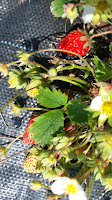Rhubarb Jelly
About
6 good sized stems of rhubarb [washed and trimmed] – enough to give about 1lb
[½ Kg]
¼
pint [ 5fl oz. 150ml] water
1
good Tblsp sugar – or to taste [ as the season progresses the rhubarb becomes
tougher and less sweet you may then wish to add a bit more sugar]
4
leaves of gelatine [ follow the instructions on the packet]
Method
·
Cut the washed rhubarb into pieces about
1inch [2cm] long.
·
Put in a saucepan with the water and
cook gently until soft.
·
Put the rhubarb into a food processor
and whizz until smooth [ or use a handheld blender].
·
To give a smoother jelly you may wish to
put it through a sieve or to give a clear jelly use a little more fruit and
strain it through a jelly bag [measure the amount of liquid and use the required
amount of gelatine specified on the packet
·
Add the sugar and stir until dissolved.
·
Pour in the prepared gelatine and stir
in well as you are pouring.
·
Put the mixture into serving dishes and
put into the fridge to set.
·
Serve with cream or ginger ice-cream.
If you are planning to serve this
on its own you may wish to add a little crystallised ginger or some orange zest
and juice to the rhubarb while it is cooking
Ginger Ice – Cream
4
large egg yolks
30g
[1 oz] icing sugar
Pinch
salt
Method
·
Set your freezer onto its fast freeze
setting.
·
Chop the ginger chunks into small pieces
and put into the portion of syrup.
·
Whisk one of the tubs of cream until it
is whisked but not too stiff.
·
Put the egg yolks, sugar and pinch of
salt into a bowl and whisk until it is pale coloured and creamy.
·
Heat the other tub of cream in a
saucepan but, do not allow it to boil.
·
Add the ginger, with the syrup into the
egg mixture and place the bowl over a saucepan of boiling water and whish
continuously as you pour the cream into it in a thin stream.
·
Continue to whisk over the hot water
until the custard starts to thicken – this method will prevent the custard
curdling or ‘splitting’.
·
Transfer the bowl to a cold bath and
continue to whisk until the bowl and custard are cold.
·
Add the remaining cream and carefully
mix in.
·
Put the custard into a suitable lidded
container and put in the freezer.
·
Every hour or so, take the custard from
the freezer and stir well then return to the freezer, until the ice-cream has
set.














